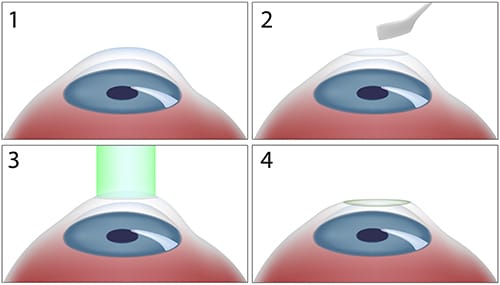Epilasek / PRK


Laser Epithelial Keratomileusis (LASEK), also known as EPILASEK, is similar to LASIK but the flap is created differently. In a EPILASEK procedure, the surgeon temporarily removes only the epithelium (top layer of the cornea) instead of the epithelium and part of the deeper stroma layer as done when creating a traditional LASIK flap. With this procedure advantages include; thirty–five percent less tissue is removed, therefore the patient’s who have thin corneas are now a candidate for laser vision correction. Also, no laser assisted flap is created or needed; therefore all complications associated with stromal flaps are eliminated. EPILASEK appears to be a superior option for patients with dry eyes.
Postoperatively, patients are not quite as comfortable as LASIK patients. Also, vision is somewhat blurry for the first 4–7 days. So, in the first postoperative week, traditional LASIK has more “wow” appeal. However, after 1–2 weeks, vision with EPILASEK is as good, or slightly better than, with LASIK. In the near future, EPILASEK is expected to be the preferred treatment for most patients.
PRK is an earlier technique of laser eye surgery that, along with LASIK, makes up the two most common forms of refractive surgeries today. The initials PRK refer to “photorefractive keratectomy”. “Photorefractive” has to do with the ability of the eye to “refract” or focus light. Keratectomy refers to a removal of a part of the cornea. PRK was the dominant form of laser eye surgery until the development of the LASIK technique.


The PRK process is very similar to LASIK. Both procedures are performed on an outpatient basis. Both use the eximer laser to reshape the curvature of the cornea in order to correct for focusing problems. The shape of the cornea largely determines how light enters the eye and is focused. So, if the curvature of the cornea is too great or too little in relationship to the length of the eye, light cannot be properly focused on the retina.
As with LASIK surgery, a computer measured map of the eye’s surface is generated prior to surgery to precisely adjust the settings of the eximer laser to your individual prescription. Before the procedure is performed, your eyes are also anesthetized with a few drops. An eyelid holder keeps the eye open as the brief laser surgery is completed. While PRK also uses a cool beam of laser light, with PRK the laser is used to remove the outer covering of the cornea (the epithelium) rather than folding it back. The PRK procedure uses the laser to remove the epithelium and then reshape the underlying corneal material. There is no incision of any kind with PRK. The outer layer of the cornea which is removed by the laser is simply allowed to regenerate over a period of about three days.
After PRK surgery, antibiotic and anti–inflammatory eye drops are prescribed to help with healing, reduce swelling and increase comfort. Since PRK removes the outer corneal covering, a bandage contact lens is used to protect the eye as it heals over the next two to three days. During this time of healing, daily eye examinations help to ensure that no infection develops. As a final step in the healing process, PRK patients are given anti–inflammatory drops for about two months following surgery.
